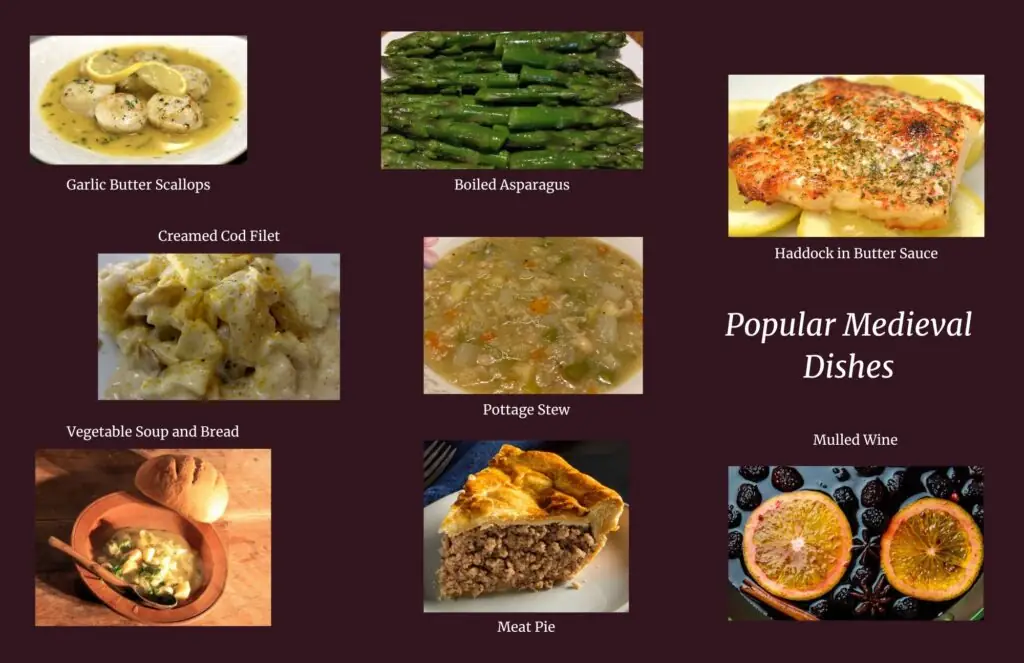Medieval food offers a fascinating glimpse into the lives of people during the Middle Ages. It’s not just about what they ate, but also about understanding their culture and everyday life. The food varied widely depending on where you were and your place in society. Nobles feasted on lavish meals, while peasants had simpler fare. Different regions had their own specialties, influenced by the local climate and available resources. By exploring the food of this era, we can learn a lot about the social structures, trade, and agriculture of the time.

✅ AI Essay Writer ✅ AI Detector ✅ Plagchecker ✅ Paraphraser
✅ Summarizer ✅ Citation Generator
Eating Habits of the Medieval Period
During the medieval period, the diet of people varied depending on their social status and location. However, some common food items were consumed across different regions and classes. Bread was a staple in the medieval diet, made from various grains like wheat, rye, or barley. Meat, including beef, pork, and poultry, was more common among the wealthier classes, while peasants often relied on fish and eggs as protein sources. Fruits and vegetables, such as apples, pears, cabbages, and onions, were also part of the diet, though the variety was limited compared to modern times.

The feudal system played a significant role in determining food availability and distribution. Under this system, peasants worked the land owned by nobles and were required to give a portion of their produce as rent. This meant that the majority of the food produced went to the nobility, leaving peasants with limited access to a diverse diet. The feudal system also influenced the types of crops grown and the livestock raised, further shaping the dietary habits of the medieval period.
The Correlation Between Social Class and Diet
In medieval society, diet was closely linked to social class, with significant differences in food quality and variety among the nobility, clergy, and peasants. The nobility enjoyed a diverse diet with plenty of meat, fish, fruits, and spices, often imported from afar. Their meals were lavish and included multiple courses, showcasing their wealth and status. The clergy, while leading a more modest lifestyle, still had access to better food than the average peasant, including a variety of meats and vegetables.
Peasants, on the other hand, had a more limited diet, primarily consisting of bread, porridge, and vegetables, with meat being a rare luxury. Their meals were simple and aimed at providing enough energy for their labor-intensive days.
Typical Meals for Different Classes:
| 🍽 Meal Time | 👑 Nobility | 🎩 Clergy | 👒 Peasants |
|---|---|---|---|
| Breakfast | Ale, bread, cheese, sometimes meat | Bread, cheese, fruits, wine | Bread, ale, sometimes cheese |
| Lunch | Multiple courses of meat, fish, fruits, and vegetables | Meat or fish, vegetables, bread, wine | Pottage (vegetable soup), bread |
| Dinner | Lavish banquet with various meats, fish, sweets, and wine | Similar to lunch, but with more variety | Bread, cheese, occasionally meat or fish |
Feasts and banquets played a crucial role in the social life of the upper classes, serving as a means to display wealth, forge alliances, and celebrate important events. These gatherings featured an abundance of food, elaborate dishes, and entertainment, further emphasizing the social divide in medieval dietary habits.
Cooking Methods and Preservation in Medieval Times
In medieval kitchens, a variety of cooking techniques were used to prepare meals. Roasting was a popular method, often done over an open fire, where meat was turned on a spit to cook evenly. Boiling was another common technique, used for making soups, stews, and pottages, a staple dish made from vegetables and sometimes meat. Baking was also used for bread, pies, and pastries, with large ovens in the kitchens of the nobility and communal ovens in villages for peasants.
Without modern refrigeration, preserving food was essential to ensure a supply throughout the year, especially during winter. Salting was a widely used method, particularly for meat and fish, which helped to prevent spoilage and extend shelf life. Smoking was another technique for preserving meat, adding flavor while also inhibiting bacterial growth. Pickling, using vinegar or brine, was employed to preserve vegetables and fruits. These methods were crucial for maintaining a food supply and preventing waste in the medieval period.
What About Spices and Flavoring?
Spices played a significant role in medieval cuisine, adding flavor and depth to dishes. Exotic spices like cinnamon, cloves, nutmeg, and pepper were highly prized and were brought to Europe through complex trade routes, including the famous Silk Road. These spices, often originating from Asia and the Middle East, were valuable commodities and a symbol of wealth and status.

In medieval cooking, spices were used generously to season meats, soups, and sauces, transforming simple dishes into flavorful feasts. They were also used in sweet dishes, such as pies and pastries, creating a distinctive blend of sweet and savory flavors that characterized medieval cuisine.
| The ten most common spices used in medieval cuisine were cinnamon, cloves, nutmeg, pepper, ginger, saffron, cumin, coriander, mace, and cardamom. |
The use of spices was not just about taste; it was also a way to display wealth and prestige. The more exotic and expensive the spices used in a dish, the higher the social standing of the host. Feasts and banquets were opportunities for the nobility to showcase their access to these precious commodities, further emphasizing the social divide in medieval society. The trade and use of spices were integral to the culinary and cultural landscape of the Middle Ages, influencing the development of European cuisine.
Conclusion
The food of the medieval period was more than just sustenance; it was a reflection of the social, economic, and religious landscape of the era. From the grand feasts of the nobility to the modest meals of the peasants, every dish tells a story about life in the Middle Ages. The impact of medieval cuisine can still be seen in some of our modern eating habits and recipes. By studying the food of this time, we gain a deeper appreciation for the rich tapestry of history and its ongoing influence on our culture today.
FAQ
Follow us on Reddit for more insights and updates.





Comments (0)
Welcome to A*Help comments!
We’re all about debate and discussion at A*Help.
We value the diverse opinions of users, so you may find points of view that you don’t agree with. And that’s cool. However, there are certain things we’re not OK with: attempts to manipulate our data in any way, for example, or the posting of discriminative, offensive, hateful, or disparaging material.